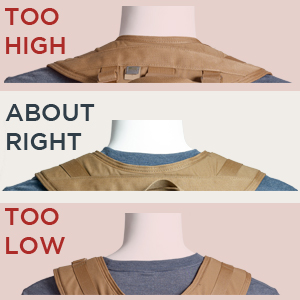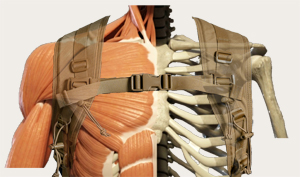
Every Hill People Gear pack uses the same shoulder harness, and needs to be adjusted so the harness rides in the correct position front to back. The HPG shoulder harness is designed to drape the shoulders and spread the load across a wide surface area without impinging on the trapezius or brachial plexus.
To set the harness, you need to lengthen or shorten the torso height so that the bottom of the pack settles into the lumbar curve and the rear center of the shoulder harness settles in 1-2" below the cervical portion of the spine as depicted in the image above and the video below. This fitment is the same regardless of how tall the pack is or whether it has load lifters. Connor, Aston House, Ute, and qui-Ya packs will all stick up above the harness on the body of an average height person. The critical dimension is between the bottom of the pack and the rear center of the shoulder harness.
If you are using a pack belt, the shoulder harness should be lightly resting on your shoulders. It's there more for stabilizing the pack than bearing any weight. If you can't easily get a couple fingers under the harness on your belted pack you need to lengthen either the torso length, harness front straps, or both.

On the front of the harness, you do not want to overtighten the bottom straps. The harness is meant to drape in such a way that the pack settles into your lumbar. The point of a sternum strap is to take the pressure off of your brachial plexus. As such, the sternum strap should be level with your brachial plexus which is about 2" below your collar bones. Tension the sternum strap just enough to take the pressure off.